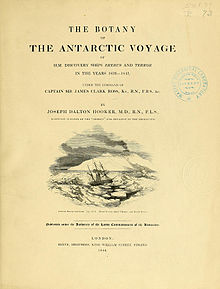Flora Antarctica

Title page with an etching of Victoria Barrier with Mount Erebus and Mount Terror; one of the expedition's ships is shown temporarily trapped in sea ice.
|
|
| Author | Joseph Dalton Hooker |
|---|---|
| Country | England |
| Language | English |
| Series | Monthly parts |
| Subject | Botany |
| Publisher | Reeve Brothers |
|
Publication date
|
1843 – 1859 |
| Text | at |
The Flora Antarctica or formally and correctly The Botany of the Antarctic Voyage of H.M. Discovery Ships Erebus and Terror in the years 1839–1843, under the Command of Captain Sir James Clark Ross, is a description of the many plants discovered on the Ross expedition, which visited islands off the coast of the Antarctic continent, with a summary of the expedition itself, written by Joseph Dalton Hooker and published in parts between 1844 and 1859 by Reeve Brothers in London. Hooker sailed on HMS Erebus as assistant surgeon.
The botanical findings of the Ross expedition were published in four parts, the last two in two volumes each, making six volumes in all:
All were "splendidly" illustrated by Walter Hood Fitch. The larger part of the plant specimens collected during this expedition are now part of the Kew Herbarium.
Although Hooker professed not to have changed his views on Darwin's theory of evolution by natural selection, the Flora of Tasmania contains an introductory essay on biogeography written from a Darwinian point of view, making the book the first case study for the theory.
The British government fitted out an expedition led by James Clark Ross to investigate magnetism and marine geography in high southern latitudes, which sailed with two ships, HMS Terror and HMS Erebus on 29 September 1839 from Chatham.
The ships docked at Madeira, Tenerife, the Cape Verde archipelago, Saint Peter and Saint Paul Archipelago, Trinidad to arrive at the Cape of Good Hope on 4 April 1840. On 21 April the giant kelp Macrocystis pyrifera was found off Marion Island, but no landfall could be made there or on the Crozet Islands due to the harsh winds. On 12 May the ships anchored at Christmas Harbour for two and a half months, during which all plants previously encountered by James Cook on the Kerguelen Islands were collected. On 20 July they sailed again to arrive on 16 August at the River Derwent, to remain in Tasmania until 12 November. A week later the flotilla stopped at Lord Auckland's Islands and Campbell's Island for the spring months.
...
Wikipedia
